
Platystemon is a monotypic genus of flowering plants in the poppy family containing the single species Platystemon californicus, which is known by the common name creamcups. It is native to Oregon, California, Arizona, Utah and Baja California, and is found in open grasslands and sandy soils below 6,000 feet (1,800 m) elevation.

Cerastium arvense is a species of flowering plant in the pink family known by the common names field mouse-ear and field chickweed. It is a widespread species, occurring throughout Europe and North America, as well as parts of South America. It is a variable species. There are several subspecies, but the number and defining characteristics are disputed.
Hieracium greenei is a species of hawkweed known by the common name Greene's hawkweed.

Lasthenia californica is a species of flowering plant in the family Asteraceae known by the common name California goldfields. It is native to California, Oregon and surrounding areas, where it is a very common member of the flora in a number of habitat types.
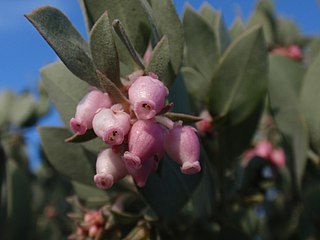
Arctostaphylos canescens, common name hoary manzanita, is a species of manzanita.
Arctostaphylos malloryi is a species of manzanita known by the common name Mallory's manzanita. It is endemic to California.

Arnica fulgens is a species of arnica known by the common names foothill arnica and hillside arnica. It is native to western North America, from British Columbia east to Saskatchewan and south as far as Inyo County, California, and McKinley County, New Mexico. It grows in open, grassy areas.

Hoita strobilina is a rare species of legume known by the common name Loma Prieta leatherroot, or Loma Prieta hoita. It is endemic to California, where it is known from occasional occurrences in the San Francisco Bay Area. It grows in chaparral and woodland habitat in the local mountains, often on serpentine soil. This is a perennial herb growing erect, approaching a meter in maximum height. The large leaves are divided into three leaflets each up to 8 centimeters long and lance-shaped to nearly round. The herbage is generally glandular and hairy. The inflorescence is a raceme up to 13 centimeters long containing many pealike flowers. Each flower is purple, sometimes with white parts, and one to two centimeters long. The fruit is a dark brown or black, hairy, veiny legume pod.
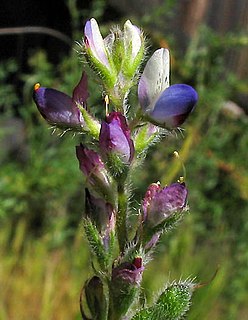
Lupinus concinnus is a species of lupine known by the common name Bajada lupine. It is native to the southwestern United States from California to Texas, and northern Mexico, where it is known from many types of habitat. This is a hairy erect or decumbent annual herb with a stem growing 10 to 30 centimeters long. Each small palmate leaf is made up of 5 to 9 leaflets up to 3 centimeters long and under a centimeter wide, sometimes narrow and linear in shape. The inflorescence is a dense spiral of flowers, with some flowers also appearing in leaf axils lower on the plant. Each flower is 5 to 12 millimeters long and purple, pink, or nearly white in color. The fruit is a hairy legume pod around a centimeter long.
Diplacus clevelandii is an uncommon species of monkeyflower known by the common name Cleveland's bush monkeyflower. It was formerly known as Mimulus clevelandii.

Nama rothrockii is a species of flowering plant in the borage family known by the common name Rothrock's fiddleleaf. It is native to the mountains and plateaus of eastern California, such as the southern Sierra Nevada, and western Nevada and Arizona, where it grows in several types of local habitat.

Nemacladus sigmoideus is a species of flowering plant in the bellflower family known by the common name sigmoid threadplant. It is native to the mountains and deserts around the intersection of California, Nevada, Arizona, and Baja California. It is a small annual herb producing a thin, spreading purplish or brown stem no more than 12 centimeters long. Hairy, sometimes toothed oval leaves up to a centimeter long occur at the base of the plant. The inflorescence is a series of zigzagging branches bearing flowers on thin pedicels which are sigmoid in shape. There is a single tiny bract at the base of each pedicel. The hairy flower is under 4 millimeters long. It has five yellow-tipped white lobes.
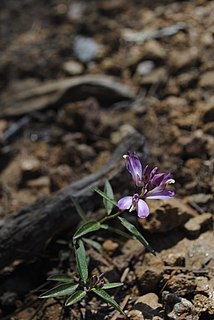
Rhinotropis californica, synonym Polygala californica, is a species of flowering plant in the milkwort family known by the common name California milkwort. It is native to southwestern Oregon and northern and central California, where it grows in the coastal mountain ranges in local habitat types such as chaparral and forest. It is a perennial herb producing spreading stems, generally decumbent in form, up to about 35 centimeters in maximum length, lined with narrow oval leaves each a few centimeter long. The upper inflorescences produce several open flowers, and there may be some closed, cleistogamous flowers lower on the plant. The open flowers have pink or white winglike lateral sepals with hairy edges. The petals are similar in color, the central one tipped with a white or yellow beak. The fruit is a flattened green capsule up to a centimeter long containing hairy seeds.
Rupertia rigida is a species of flowering plant in the legume family known by the common name Parish's California tea, or Parish's rupertia.
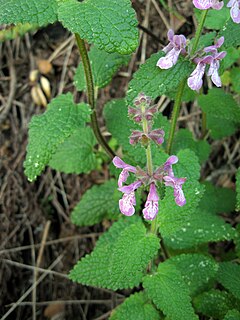
Stachys bullata is a species of flowering plant in the mint family known by the common name California hedgenettle.

Stachys chamissonis is a species of flowering plant in the mint family known by the common name coastal hedgenettle. It is a perennial herb native to the west coast of North America, where it grows in moist coastal habitat from Alaska to central California. This mint produces an erect stem 1 to 2+1⁄2 meters. It is hairy, glandular, and aromatic. The oppositely arranged leaves have pointed, wavy-edged blades up to 18 centimeters (7.1 in) long which are borne on petioles. The hairy, glandular inflorescence is made up of interrupted clusters of up to six flowers each. The flower has a deep pink tubular corolla which can be over 3 centimeters (1.2 in) long. The corollas are borne in hairy calyces of purple or purple-tinged sepals.

Trifolium angustifolium is a species of clover known by the common names narrowleaf crimson clover, narrow clover and narrow-leaved clover.

Trifolium eriocephalum is a species of clover known by the common name woollyhead clover or hairy head clover.
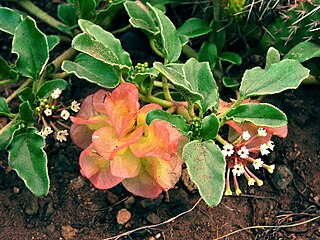
Tripterocalyx micranthus is a species of flowering plant in the four o'clock family known by the common names smallflower sandverbena and small-flowered sand-verbena.

Wyethia angustifolia is a species of flowering plant in the family Asteraceae known by the common names California compassplant and narrowleaf mule's ears. It is native to the west coast of the United States from Washington to California, where it grows in grassland, meadows, and other open habitat. It is a perennial herb growing from a tough taproot and caudex unit and producing a stem 30 to 90 centimeters tall. The leaves have lance-shaped blades up to 50 centimeters tall. The inflorescence produces one or more large sunflower-like flower heads at the top of the hairy stem. The head has narrow, hairy phyllaries at the base. It contains up to 21 yellow ray florets each up to 4.5 centimeters long and many yellow disc florets. The fruit is an achene which may be nearly 2 centimeters long including its pappus.















